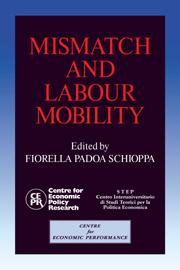Book contents
- Frontmatter
- Contents
- List of figures
- List of tables
- Preface
- Acknowledgements
- List of conference participants
- 1 A cross-country comparison of sectoral mismatch in the 1980s
- 2 Mismatch: a framework for thought
- Discussion
- 3 Match and mismatch on the German labour market
- Discussion
- 4 Mismatch in Japan
- Discussion
- 5 Mismatch and internal migration in Spain, 1962–86
- Discussion
- 6 Regional inequalities, migration and mismatch in Italy, 1960–86
- Discussion
- 7 Skill shortages and structural unemployment in Britain: a (mis)matching approach
- Discussion
- 8 Labour market tightness and the mismatch between demand and supply of less-educated young men in the United States in the 1980s
- Discussion
- 9 Skill mismatch, training systems and equilibrium unemployment: a comparative institutional analysis
- Discussion
- 10 Unemployment, vacancies and labour market programmes: Swedish evidence
- Discussion
- 11 Mismatch and labour mobility: some final remarks
- Index
Discussion
Published online by Cambridge University Press: 05 October 2010
- Frontmatter
- Contents
- List of figures
- List of tables
- Preface
- Acknowledgements
- List of conference participants
- 1 A cross-country comparison of sectoral mismatch in the 1980s
- 2 Mismatch: a framework for thought
- Discussion
- 3 Match and mismatch on the German labour market
- Discussion
- 4 Mismatch in Japan
- Discussion
- 5 Mismatch and internal migration in Spain, 1962–86
- Discussion
- 6 Regional inequalities, migration and mismatch in Italy, 1960–86
- Discussion
- 7 Skill shortages and structural unemployment in Britain: a (mis)matching approach
- Discussion
- 8 Labour market tightness and the mismatch between demand and supply of less-educated young men in the United States in the 1980s
- Discussion
- 9 Skill mismatch, training systems and equilibrium unemployment: a comparative institutional analysis
- Discussion
- 10 Unemployment, vacancies and labour market programmes: Swedish evidence
- Discussion
- 11 Mismatch and labour mobility: some final remarks
- Index
Summary
The study by Bentolila and Dolado is an important attempt to shed some light on the working of the Spanish labour market and to provide, eventually, a partial explanation for the dramatic rise in Spanish unemployment from 1% in 1960 to almost 22% in 1985 and for its persistence at those unprecedented levels thereafter. The authors explicitly refer, in the latter respect, to the study by Bentolila and Blanchard (1990) where it is suggested that high unemployment could have reduced the willingness to work in other regions, thereby inhibiting labour mobility and determining a regional mismatch from the labour supply side. Bentolila and Dolado deal, first, with the basic issue of measurement of mismatch and suggest that the usual indicator based on relative unemployment rate dispersion should give way to alternative measures of mismatch explicitly derived from disequilibrium models of the labour market. Having thus documented the rise of mismatch throughout the sample period, Bentolila and Dolado focus on its major determinants and set up an econometric model of internal migration in Spain. The main result appears to be that migration flows respond non-linearly to unemployment so that migration flows are lower the higher the unemployment rate, thereby providing support for Bentolila and Blanchard's case.
Bentolila and Dolado's study has certainly to be commended for its neat presentation of the Spanish case and for its painstaking collection and thorough analysis of regional Spanish data. The evidence presented in the study is well organised and the case for focusing on the deficient matching between labour supply and demand is definitely well augmented.
- Type
- Chapter
- Information
- Mismatch and Labour Mobility , pp. 234 - 236Publisher: Cambridge University PressPrint publication year: 1991



